Tips for visiting the Tower of London in 2024
Visiting and getting inside the popular attraction of the Tower of London is on every tourist’s bucket list when they come to London. The Tower of London’s lurid terrible history is a major part of my obsession with British history and I couldn’t wait to get inside the Tower of London. Yeah I know that sounds so dramatic but please this place has seen more tears and drama than any other in London so go with it.
Funnily enough, some visiting tourists find the Tower of London, “boring, misogynistic, traumatic for children and terribly violent and upsetting for kids”. Guess they didn’t learn any history anywhere lol.
We were very lucky to have received complimentary passes to the Tower of London from the Historic Royal Palaces they bring the six historic Palaces and their stories to life.

- Tips for visiting the Tower of London in 2024
- Frequently Asked Questions: Everything you need to know for 2024
- What is the best way to explore the Tower of London?
- How can I skip the long lines at the Tower of London?
- What are the must-see attractions within the Tower of London?
- How can I plan my visit to the Tower of London effectively?
- Is there a convenient way to reach the Tower of London?
- Is the Tower of London worth visiting?
- Is it free to visit the Tower of London?
- How long does it take to do Tower of London?
- When is the Tower of London open?
- What's the best way to see the Tower of London?
- What is the Tower of London famous for?
- How long does it take to walk through the Tower of London?
- Who owns the Tower of London?
- Who was beheaded in the Tower of London?
- Who is the Keeper of the keys Tower of London?
- Tower of London history timeline – facts about Tower of London
- How to get to the Tower of London and Tower Bridge
- Tips for visiting the Tower of London
- Map of Tower of London
- Tower of London ticket price and access to the Tower
- Yeoman Warder Tour
- WHAT IS THE CEREMONY OF THE KEYS?
- 11 Secrets of the Tower of London
- Inside the Tower of London and its history
- Visit the Chapel royal: The Chapel of St. Peter ad Vincula
- Frequently Asked Questions: Everything you need to know for 2024
Xyuandbeyond is reader-supported. When you buy through links on our site, we may earn an affiliate commission. You can read my privacy policy here.
Ultimate Guide to the London Eye – the giant Ferris Wheel in London
Frequently Asked Questions: Everything you need to know for 2024
What is the best way to explore the Tower of London?
When visiting the Tower of London, it is recommended to start your experience with a guided tour to gain a thorough understanding of this historic attraction. You can also opt for an audio guide for a more personalized tour?
How can I skip the long lines at the Tower of London?
To avoid the crowds, consider booking tickets online in advance or purchasing a London pass that includes fast-track entry to the Tower of London. Another option is to arrive early in the morning to beat the rush.
What are the must-see attractions within the Tower of London?
During your visit, make sure to explore iconic sights such as the crown jewels in the white Tower, the bloody Tower, and the torture at the Tower exhibit. Don’t miss the entertaining beefeater tour for fascinating insights.
How can I plan my visit to the Tower of London effectively?
Before you go, it’s essential to plan your visit by checking the time to visit London tour or London travel, and considering nearby accommodation options like a hotel in London.
Is there a convenient way to reach the Tower of London?
The Tower Bridge is a popular route to access the Tower of London, and you can also walk from the Tower to nearby landmarks like London Bridge or Tower pier. Public transport is readily available for those near the Tower of London.
Is the Tower of London worth visiting?
Yes if you love history and understanding where London began you must visit the Tower. William the Conqueror built the Tower and since that time it has been a critical part of London’s history.
Is it free to visit the Tower of London?
No the Tower of London is not free to visit currently Adult tickets cost £29.90 and Child (age 5-15) £14.90
How long does it take to do Tower of London?
I would plan for at least 3 hours to see the Tower of London. The lineup for the Crown Jewels alone could take up to an hour as it can get quite extensive.
When is the Tower of London open?
During the summer months – Daily: Mondays and Sundays: 10.00-17.30. Last admission: 16.30. Tuesday – Saturday: 09.00-17.30. Last admission: 16.30.
What’s the best way to see the Tower of London?
I suggest taking your time and doing a self-guided tour of the Tower, however, you can also take some great guided tours you can read about below.
What is the Tower of London famous for?
Murder, mayhem, beheadings, and torture the Tower of London is history personified.
How long does it take to walk through the Tower of London?
You will need around 3-4 hours to see everything the Tower of London has to offer, sometimes in full tourist season the lineups to see the Crown Jewels will take around 2 hours
Who owns the Tower of London?
These days the Tower of London is owned by King Charles and it is Crown property.
Who was beheaded in the Tower of London?
22 executions occurred in the Tower of London, which is said to be haunted by the deaths that took place there. The last execution on Tower Hill was of a treasonous man and took place in 1747. Lady Jane Grey and Anne Boleyn were executed there by King Henry VIII.
Who is the Keeper of the keys Tower of London?
The Keeper of the Keys is the Yeoman Warder and the Ceremony of the Keys is the traditional locking up of the Tower of London and has taken place on each and every night for at least 700 years.
Tower of London history timeline – facts about Tower of London
1078 – Construction of the White Tower begins.
1080 – The Chapel of St. John is consecrated
1100 – The very first prisoner in the Tower, Ranulf Flambard, Bishop of Durham, escapes by climbing down a rope.
1140 – The Tower is first used as a royal residence
1221 – Building of the Wakefield Tower
1241 – The White Tower is whitewashed
1264 – The Royal Menagerie is begun
1297 – John Baliol, King of Scotland, imprisoned in the Tower.
1300 – The Beauchamp Tower was built.
1322 – The Ceremony of the Keys began.
1381 – Peasant’s Revolt. The Tower is stormed by an angry mob.
1471 – King Henry VI dies mysteriously, probably murdered, in the Tower.
1483 – Disappearance of the Princes in the Tower.
1530 – Building of Queen’s House
1536 – Anne Boleyn beheaded on Tower Green
1554 – Lady Jane Grey executed.
1649-1660 – Cromwell’s rule sees the Crown Jewels melted down and sold. Many pieces were later recovered by the crown.
1660 – The Tower ceased regular use as a prison. Defences were improved, and the garrison was used to keep the peace in London.
1660 – First sightseers were admitted to the Tower.
1671 – Colonel Thomas Blood attempts to steal the Crown Jewels from the Martin Tower. Blood is captured but mysteriously pardoned by the king.
1674 – Discovery of bones thought to be those of the ‘Princes in the Tower’ during renovation work
1804 – The royal menagerie opened to the public for the first time.
1834-1835 – The Royal Menagerie moved from the Lion Tower to form the London Zoo. Most of the Lion Tower demolished
1843 – The moat is drained and filled
1851 – Architect Anthony Salvin was brought in to restore the Tower
1914-1916 – during WWI a total of 11 German prisoners were shot as spies in the Tower
1939-1945 – Severe bomb damage to many parts of the tower during WWII
1942 – Rudolf Hess briefly held in the King’s House
1952 – The Krays held in the tower for 4 days, making them among the very last prisoners to be held here
1994 – The Crown Jewels were moved to a new location in the Jewel House
How to get to the Tower of London and Tower Bridge
Grab some Tube tickets and head towards the Tower Hill tube stop. There’s a fabulous view over the Tower from the platform next to the Underground sign. From there you cross the road and can walk along the castle or take the tunnel to the entrance area to the Tower. The ticket booths are here if you haven’t booked a ticket online.
You can also take a bus to the Tower. Bus services 15, 42, 78, 100 and RV1 all stop near the Tower of London.
Take advantage of the Tower Bridge Tour while you are in the area. A self-guided visit to Tower Bridge allows you to see the inside at your own pace. For £12.30 you get to see in the Towers, the walkways, view the Thames River through the glass floors and see the engine room.

Tips for visiting the Tower of London
1) It’s an expensive tour that’s for sure so my top tip is to use the London Pass. For a two day stay in London for the London Pass you are looking at 99 Euros but it includes entry to over 80 attractions and includes the Hop on Hop Off bus, The Tower (which is 30 alone), the Shard’s brilliant views and much more.
Map of Tower of London
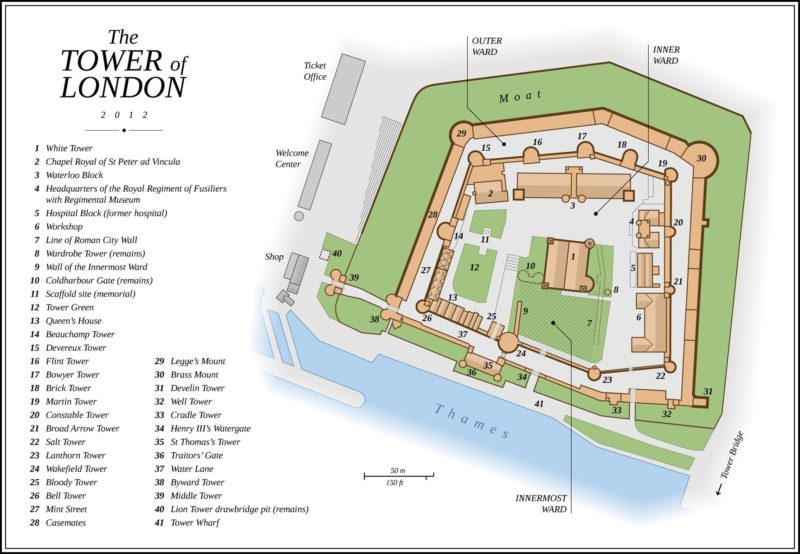
2) Keep in mind that it is incredibly busy in the summer months and you may get really annoyed with the crowds and crowds of people. So a great tip is to visit the Tower in the winter months where there are still hordes but considerably fewer.
3)Tower of London Tour for the only way to see the Opening ceremony inside the Tower of London is to take an “early bird” tour. These tours cost a lot more than just the entry fee however they allow you to see the ceremony and explore areas without being crushed to death by other tourists. Get your Guide has an awesome early bird tour. This is a skip the line and the crowds access for around € 64.63 per adult.
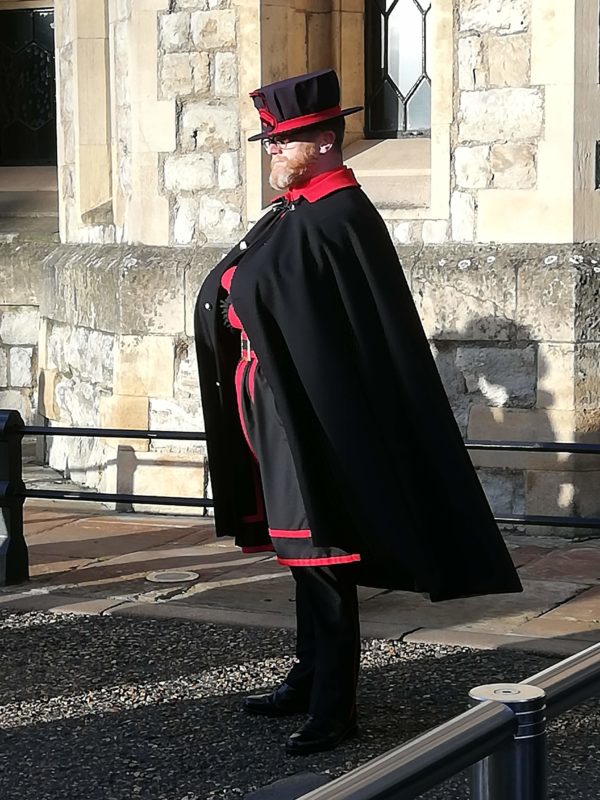
4) Book your tickets online if not taking a tour it’s the easiest way Buying your tickets online is the cheapest and most convenient way to visit the Tower. You can either book your tickets online in advance of your visit (recommended), or you can buy tickets from the ticket office which is near the main entrance. Carers and support persons are admitted free of charge.
5) You are not allowed to take photos of the Crown Jewels and of the displays within the White Tower so keep that in mind.
6) The inside of the Tower of London is accessible to the mobility impaired and wheelchair users and you can download a guide here. There are wheelchairs for hire and carers do get in free. It is a LOT of walking and steps up and down into the various Towers so be prepared if you have mobility or walking problems.
7) if you can’t afford the early bird tours then go as early as the place opens so Tuesday-Saturday: 09:00-17:30 and Sunday-Monday: 10:00-17:30. So get there right a 9 am or 10 am depending on the day. Now the last admission is 17:00, they reckon it takes around 2 hours to see the whole site so if you get there around 15:00 the crowds will be thinning a little.
8) You are only allowed a small bag or backpack and there are no left luggage facilities and large bags are not permitted in the Tower.
9) A London City Pass is another way to save money on admission to the Tower of London. Entry to the Tower of London is included in both the London Pass and the London Explorer Pass.
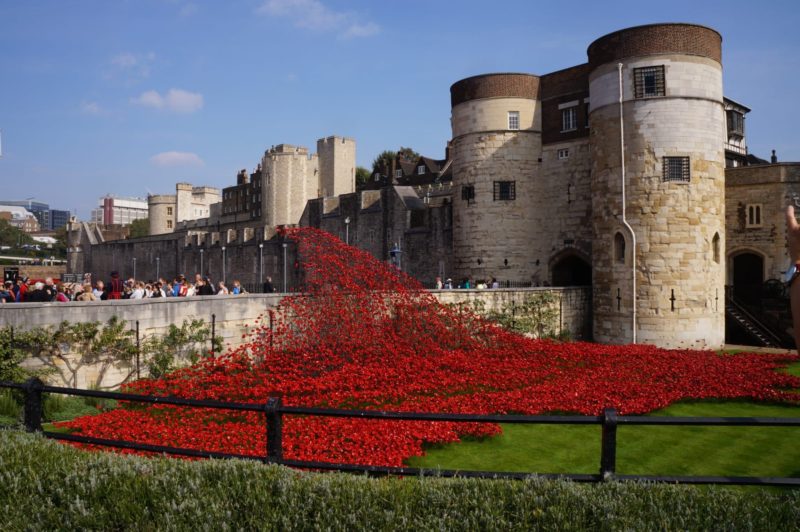
Tower of London ticket price and access to the Tower
Currently, it is advised to book your tower of London tickets online and book a timeslot. You can also purchase tickets on the day from the ticket office on Tower Hill. Audio guide tours in a choice of languages are available to purchase with your ticket.
An Adult Ticket costs £37.00 and a children’s ticket is £18.50. You can get Tower of London tickets 2 for 1 when you buy a London City Pass.
An admission ticket includes entry to The Crown Jewels, The White Tower, Chapel of St Peter ad Vincula, Battlements, Medieval Palace, Bloody Tower, Torture at the Tower exhibition, Fusiliers Museum and Royal Mint exhibition.
Yeoman Warder Tour
Yeoman Warders, also known as ‘Beefeaters’, will share key stories from 1,000 years of history. Be entertained by tales of intrigue, imprisonment, execution, torture and much more on this guided tour of the Tower.
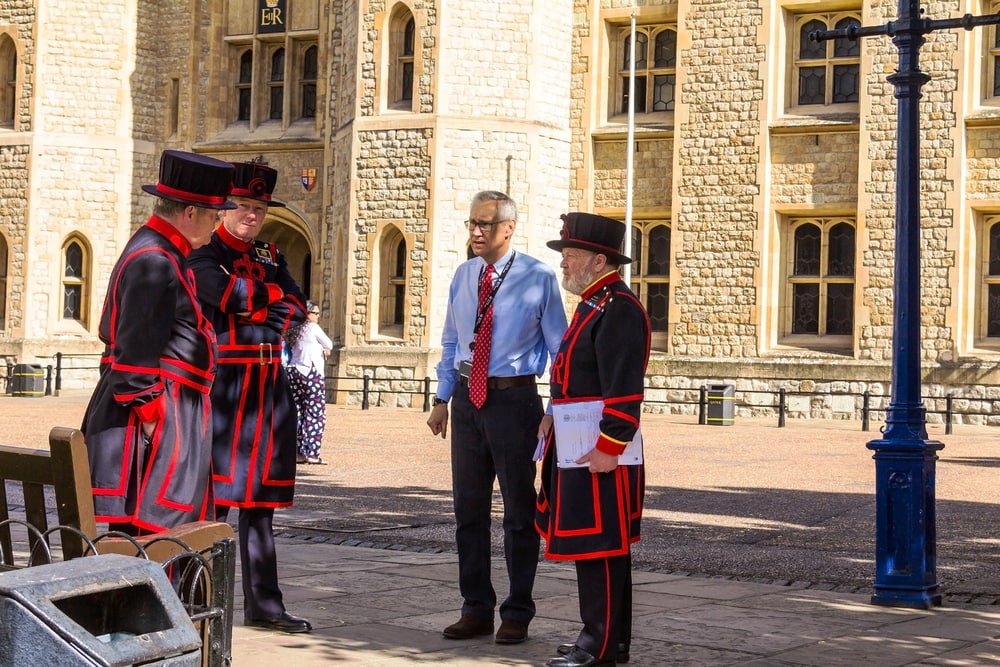
Yeoman Warder tours are included in the entrance charge of a visit to the Tower. They take place twice an hour (approximately 00 and 30) and last about 60 minutes. The last tours of the day are at about 1530 in summer and 1430 in winter. Look for the Warder tour start point near the main entrance of the Tower.
Tours begin every 30 minutes. See times. Tours are included as part of an admission ticket and there is no need to book in advance.
WHAT IS THE CEREMONY OF THE KEYS?
Footsteps echo in the darkness. The sentry cries out, ‘Halt, who comes there?’ The Yeoman Warder replies, ‘The keys.’ ‘Whose keys?’ ‘King Charles’ keys.’ ‘Pass then, all’s well.’ This has been said for centuries during the ceremonial closing of the Tower at night.
The Ceremony of the Keys is one of the oldest surviving enactments of its kind. Although the king may no longer reside at the Tower, the Crown Jewels and many other invaluable objects still do, therefore its importance is still relevant today.
Tickets for the Ceremony of the Keys must be pre-booked in advance, online only. It becomes fully booked very quickly. The meeting point for the Ceremony of the Keys is the main entrance to the Tower of London, West Gate. Cost of this tour is £5.00 and it gets booked very quickly.
The ceremony concludes at 22.05 after which all visitors are escorted to the exit. There are no toilet or refreshment facilities available. There is limited accessibility – please email [email protected] if you have any special requirements.
11 Secrets of the Tower of London
The Tower of London doubled as the Mint and for 500 years, beginning in 1279, the Tower of London guarded the country’s Mint. Until 1663, coins were hammered by hand.
It protects $32 billion worth of treasure in the Crown Jewels—a priceless collection of historic ceremonial objects—that have been on display since the 17th century. Among the most prized items is the Star of Africa, a single diamond worth $400 million, and the Imperial Crown, which sits protected in a bullet-proof glass case, and is embedded with exactly 2,868 diamonds, 273 pearls, 17 sapphires, 11 emeralds and 5 rubies.
Before the Tower was a prison, it was a zoo where King John kept an exotic menagerie in 1210. The zoo included lions, ostrich, elephants, and even a polar bear who had to hunt in the Thames river for his fish dinners.
In the 1500s Hew Draper from Bristol was accused of sorcery and he was incarcerated in the Tower. Today you can see where he left astrological signs on the stone walls of his cell in the Salt Tower.
Despite what has become known as the lurid history of the Tower of London apparently only 22 people were actually executed at the Tower. The last person to be executed by the firing squad was a German spy Josef Jakobs in 1941.
Charles II insisted that the resident ravens—six in total, plus one spare—should be protected forever as the Guardians of the Tower. Charles had a dream in which the Tower would fall if the ravens deserted it. The ravens are an important part of the Tower legends and are cared for and housed by the Raven Master.
The last people to be held in the Tower were the legendary east-end gangsters the Kray twins. They were imprisoned for a few days in 1952 for failing to report for national service.
What is hiding under the Tower of London? According to an ancient legend, there is buried treasure hidden at the Tower of London. Under Cromwell, it’s said that former Lieutenant of the Tower Sir John Barkstead hid 20,000 gold coins somewhere on the grounds. Apparently, Samuel Pepys went digging in the cellars for the treasure when he heard of the legend.
Other secrets of the Towner of London include Sir Thomas More’s cell behind a hidden door in the King’s House, and the toilet built for Adolf Hitler when it was thought he could be imprisoned at the Tower during WWII.
One of the Tower’s greatest mysteries is the lost princes. These young boys disappeared in the Tower while under the custody of Richard, Duke of Gloucester — it’s widely believed that Richard had the boys killed but their bodies have never been found. An Essex historian, whose research was crucial in helping to identify the remains of Richard III, has found enough DNA to see if the bones that were found in the Tower are that of Richard and Edward.
The bones of two young people were found at the Tower in 1674 and taken to Westminster Abbey. It is hoped that King Charles will now allow DNA testing of the bones found at the Tower to prove definitively if they are those of Edward and Richard.
Inside the Tower of London and its history
The Tower of London is officially speaking Her Majesty’s Royal Palace and Fortress of the Tower of London. It is located on the north bank of the Thames in Central London and is pretty hard to miss. It was founded in around 1066 as part of the Norman conquest.

When was the Tower of London built? The oldest building inside the Tower of London is called the White Tower, which essentially gave the Tower of London its name. The White Tower was built by William the Conqueror in 1078 and the people of London just hated it. It became a prison in 1100. That was not its purpose though in its early days it did serve as a royal residence and had two rings of defensive walls and a moat.
Inside the White Tower
The White Tower was the scene of one of the most infamous murder mysteries in British history. That of the Princes of the Tower and of course Shakespeare wrote about in Richard III. There is a beautifully preserved 11th-century chapel located in the tower.
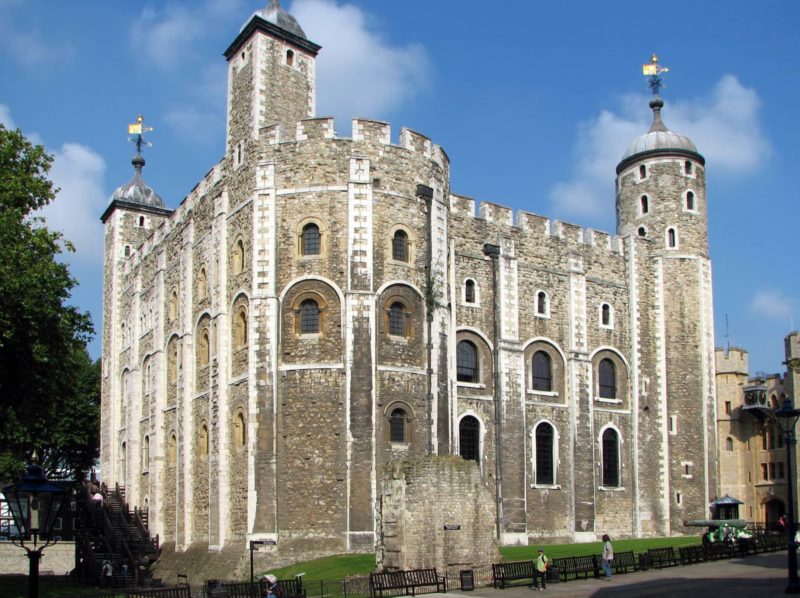
These days though it seems that historians are turning up the truth about the murders and noticing that this story may have just been what we call today a spin put on the disappearance of the two Princes to discredit Richard.
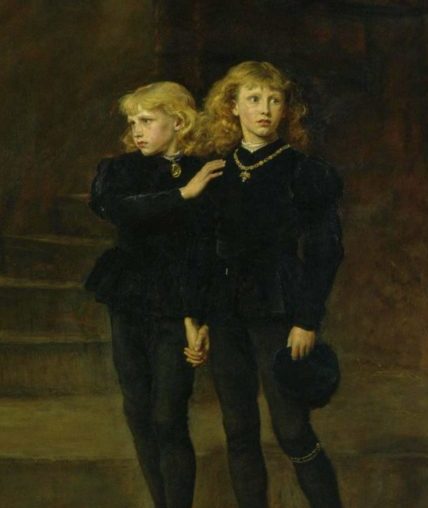
Historians are turning up new evidence every day and are still awaiting the possibility of DNA evidence on the two young sets of bones discovered in the 1600s to see if the truth will out as Shakespeare would say.
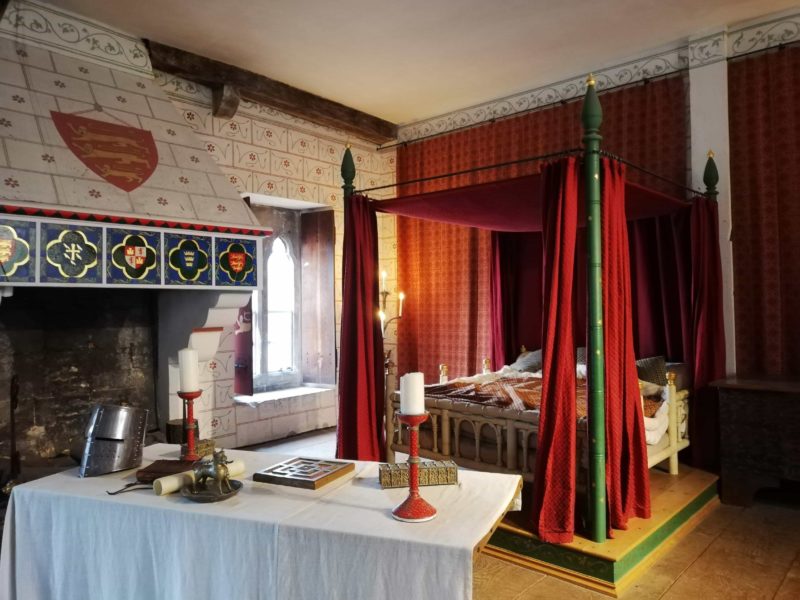
The White Tower also includes some incredible displays of suits of armour and arms that have been on display for over 300 years. You can even get a close-up of Henry VIII’s jousting armour and codpiece. The White Tower also includes masks of all the medieval monarchs carved out of wood.

The White Tower at the Tower of London is a fascinating recreation of the 13th-century palace and you can see how Henry VIII would have lived in the ultimate of luxury for the times. There is also an exhibit of artefacts from the Kings who lived here.
Mint Street
Is an exhibition that details the history of the Royal Mint which used to be based inside the Tower of London before being moved to Wales. This exhibit has displayed many of the actual artefacts produced in Mint Street and lots of tales of robberies and infamous thefts.
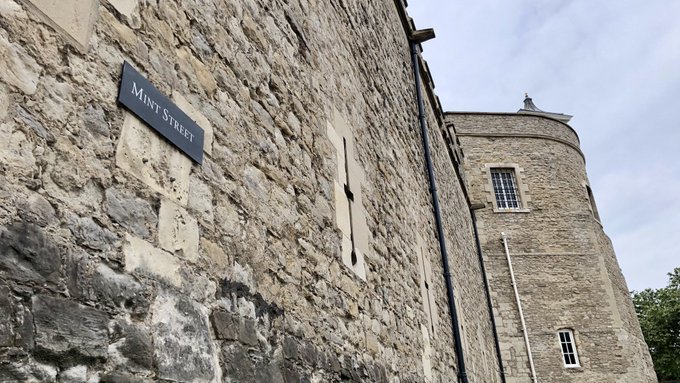
Tower Green
The absolute most famous execution site in the world this site was used for executions for Henry VIII wives, Anne Boleyn and Jane Grey right up to those convicted of spying during WWII.

Visit the Chapel royal: The Chapel of St. Peter ad Vincula
The Chapel is fascinating but you will only get to see inside it as part of a Yeoman Warder led tour. A Chapel Royal, in existence since the 12th century, St. Peter ad Vincula is the final resting place of those executed within the walls of the Tower.
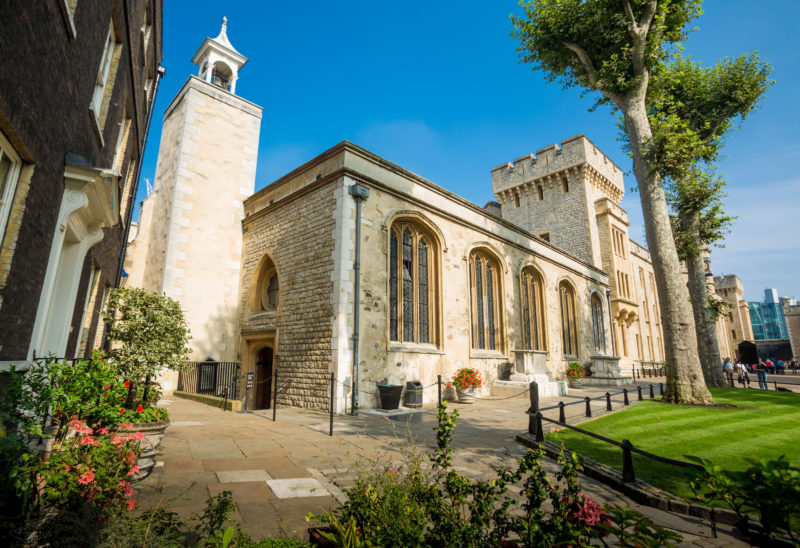
It is the designated place of worship for all of those who work (and live!) inside the Tower. With memorials and statues designated to famous faces of the church’s history, buried inside are two of Henry VIIIs wives, as well as two saints: Sir Thomas Moore and Bishop John Fisher.
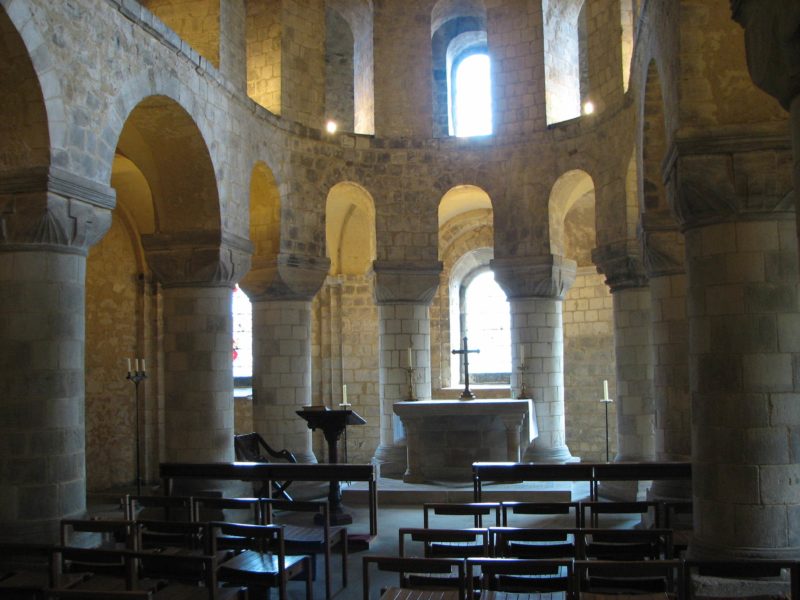
Inside the Tower of London – Visitor Tips
To get inside the Chapel, one can only enter as part of a Yeomen Warder led tour, and you can find these tours which are signposted throughout the Tower of London. The Beefeaters or Yeoman will fascinate you and regale you with tales of intrigue, murder, ghosts and the legends of the Tower of London’s ravens. This is a free tour when you are inside the Tower of London.
Towers within The Tower
There are in fact 9 towers within the Tower of London that have held prisoners including Sir Walter Raleigh, Queen Elizabeth, Lady Jane Grey and many more not so well known.
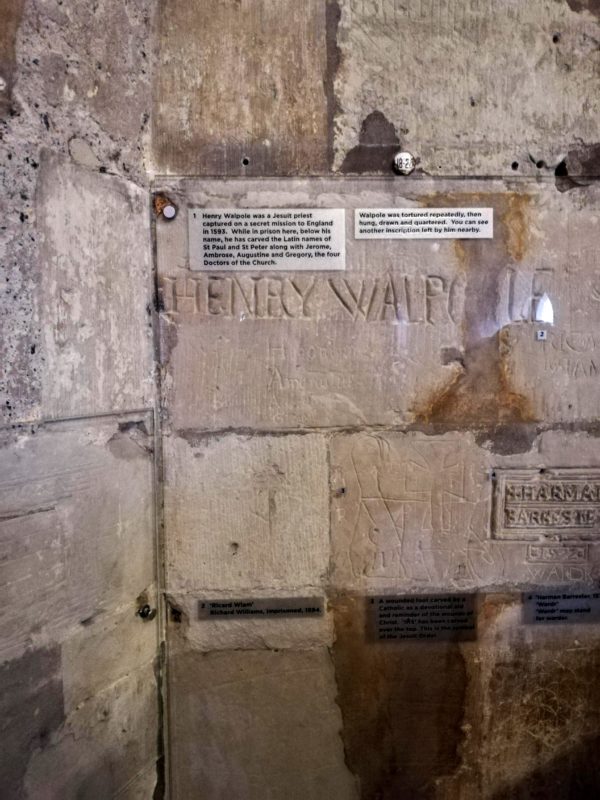
The Salt Tower, The Bloody Tower, and The Beauchamp Tower tours give you a chance to see some of those prisoners’ final words. Scratched into the stone walls these words are graffiti left by prisoners in their final hours.

One of those tortured at the Tower was Guy Fawkes, who was responsible for the Gunpowder Plot to blow us the Houses of Parliament. He was brought to The Tower on the 8th of November and tortured to sign a full confession of the Plot.
Traitors’ Gate
Traitors’ Gate faces the Thames River and is believed to be the entrance through which many prisoners of the Tudors, Henry VIII and Elizabeth I arrived. The gate was built by Edward 1st to provide a water entrance to The Tower.
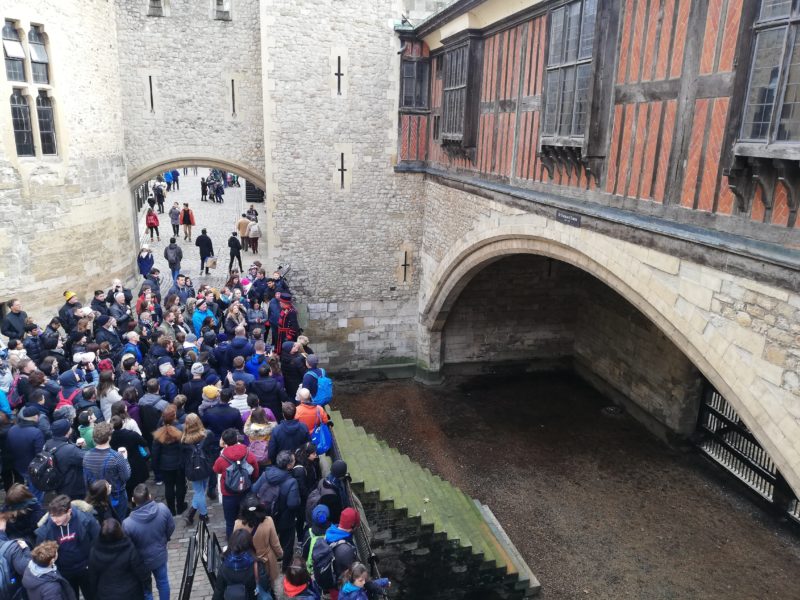
There is a pool behind Traitors’ Gate where an engine sat that worked by the force of the Thames tide and assisted in raising water to a cistern on the roof of the White Tower. When the tides weren’t great enough horsepower was used and then that changed to steam. In the 1700s the engine was used to drive the machiner to bore gun barrels but is was removed in the 1860s.
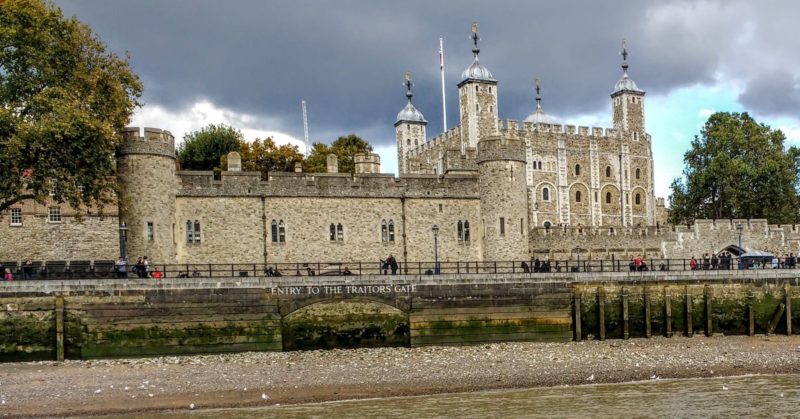
Prisoners were brought by barge along the Thames, passing under London Bridge, mainly to intimidate them as they could see the heads of the executed displayed on pikes along the river. Sir Thomas More entered The Tower by Traitors’ Gate but Anne Boleyn did not.
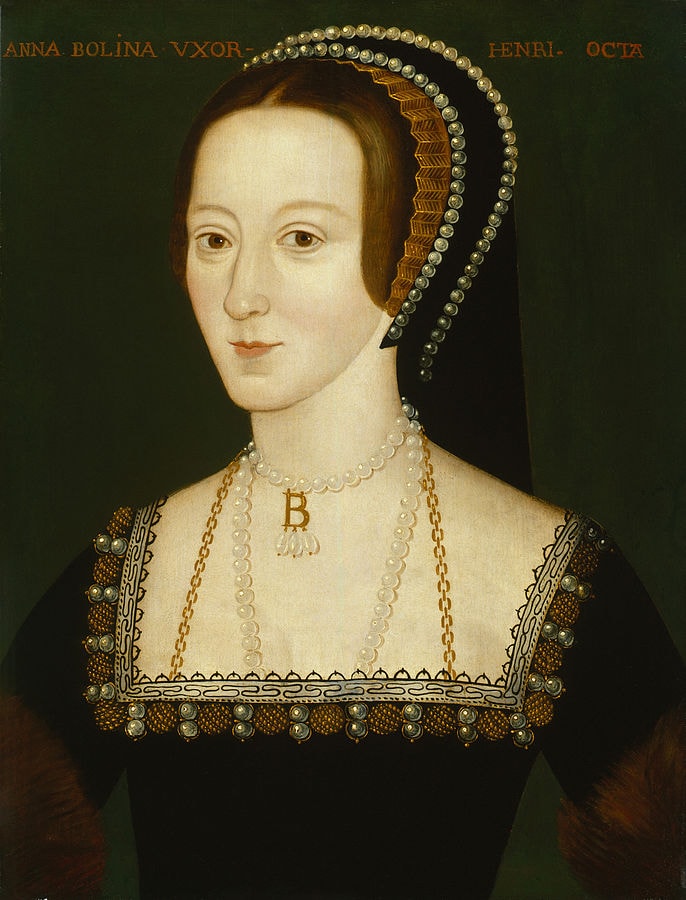
It is often told that Anne Boleyn entered The Tower from the Gate but she was actually brought in through the Court Gate which stands in the Byward Tower.

Ghosts in the Tower of London
There are said to be 13 ghosts in the Tower of London including:
- Guy Fawkes – Guy Fawkes was taken to the Tower of London after his part in a plot to assassinate James I at parliament in 1605. Imprisoned in the Queen’s House, Guy Fawkes was subjected to intense torture, likely on the rack in the White Tower dungeons.
- Henry VI. – Imprisoned in the Wakefield Tower of the Tower of London, Henry VI was murdered at the altar in the King’s Private Chapel in 1471 close to midnight. Henry’s ghost is believed to haunt the Wakefield Tower, appearing on the stroke of midnight.
- Sir Walter Raleigh. – Sent to the Tower no less than three times, explorer Sir Walter Raleigh was imprisoned by both Elizabeth I and James I, spending over 13 years in the Bloody Tower during one confinement, and attempting suicide. Sir Walter Raleigh’s last imprisonment at the Tower of London, in the Beauchamp Tower, took place in 1603, before he was beheaded outside the Palace of Westminster.
- The faceless young woman. – In 1957, Welsh Guardsman Johns was on sentry duty at the Salt Tower when he encountered a shapeless form with the face of a young woman, perhaps one of the many women who suffered a terrible fate at the Tower of London.
- Margaret Pole – Like Anne Boleyn, the beheading of Margaret Pole, Countess of Salisbury took place on Tower Green, which lies to the west of the White Tower. Brought to the scaffold by Henry VIII for the crime of being the mother of Cardinal Pole who opposed Henry’s self-created position as Supreme Head of the Church of England, Margaret Pole was 67 at the time of her death. Eyewitnesses say the executioner on a fateful day in 1541 was a “wretched and blundering youth” who, unable to perform a clean execution with his axe, instead hacked at Margaret Pole’s head and shoulders. That eternal scream echoes through the towers today.
- The white figure. – The Tower of London is protected by the Yeoman Warders, nicknamed Beefeaters. In 1864, Captain J.D Dundas observed a Yeoman attempting to charge a ‘whitish, female figure’ with his bayonet. Chillingly, this apparition appeared in the courtyard where Anne Boleyn was beheaded.
- Lady Jane Grey. – Known as the English queen with the shortest reign, protestant Lady Jane Grey became Queen after the death of King Edward VI, son of King Henry VIII. Edward named Lady Jane Grey as his heir in his last will, over his half-sister Mary. On Edward’s death on 6th July 1553, Lady Jane Grey became Queen, a title she was to hold for just 9 days before the council decreed that Catholic Mary was the true ruler of England. Lady Jane Grey, and her husband Dudley, were executed on the infamous Tower Green in 1554. The white figure of Jane is said to haunt the battlements of the Tower of London to this day.
- The monk’s footsteps. – If you visit the Tower of London, listen out for the sound of sandals slapping against the stone floors, reported to be from the steps of a ghostly monk.
- Arbella Stuart – An oft-repeated ghost sighting at the Tower of London is that of Arbella Stuart, cousin to Elizabeth I. Arbella was imprisoned by James I for marrying William Seymour, nephew of Lady Jane Grey, without Royal consent. Seeing this match as a possible threat to his throne, James placed Arbella under arrest at the Tower, where she either refused to eat or was purposefully starved. Arbella’s ghost is thought to stalk the Queen’s House.
- The lost princes. – On the death of Edward IV, Edward’s young son, 12-year-old Edward became King Edward V, under the protection of his uncle, the Duke of Gloucester. Wanting to take the crown for his own, the Duke of Gloucester imprisoned Edward and his young brother Richard in the Tower of London. Their mother, Elizabeth Woodville took sanctuary at Westminster Abbey. After declaring young Edward illegitimate, the Duke of Gloucester became King Richard III and Edward and Richard were never seen again, believed to be murdered at the order of their uncle. The bones of two children were later found beneath a staircase in the Tower of London.
- The nameless thing. – The ‘nameless thing’, a petrifying spirit which follows the guards of the Tower as they walk their beat from the river’s Sally Portal entrance. In 1817 a glowing apparition was seen by the Keeper of the Crown Jewels. He claimed to have seen a glowing ghost over the shoulder of his wife which led her to scream “Oh, Christ! It has seized me!”
- Anne Boleyn – Anne was beheaded in 1536 and her ghost is said to haunt the Church of St Peter ad Vincula in the Tower, where she is buried. The legend says that she has been seen walking around the White Tower carrying her head under her arm.
- The Bear – There have been several ghost stories told by the night staff of The Tower over the years. In 1816 a sentry claimed to have witnessed a bear coming toward him, it is said he died of fright several days later.

Visit to the Crown Jewels
The lineups to see the Crown Jewels will be large at any time of year. We went in December and it still took 30 minutes to pass through the exterior and interior lines.
Once you go through the internal corridors and see a few sceptres and orbs you are ushered into the Jewel Room where you hop on an escalator that literally whisks you in front of the Crowns and you barely get a moment to see the various crowns. That, to be honest, is very disappointing. There is the final crown before the exit which you can study however with such crowds it is almost impossible to see.

The Ravens at the Tower of London
You may get to see one or more of the six ravens that are kept at The Tower. These ravens are believed to be a good luck charm of sorts and if they leave The Tower the Kingdom will fall. There is a Ravenmaster who is one of the Yeoman Warders who tends to the Ravens.
These birds are so much bigger than you expect and there are warning signs all around to be careful they may not fly since their wings are clipped but they do bite.
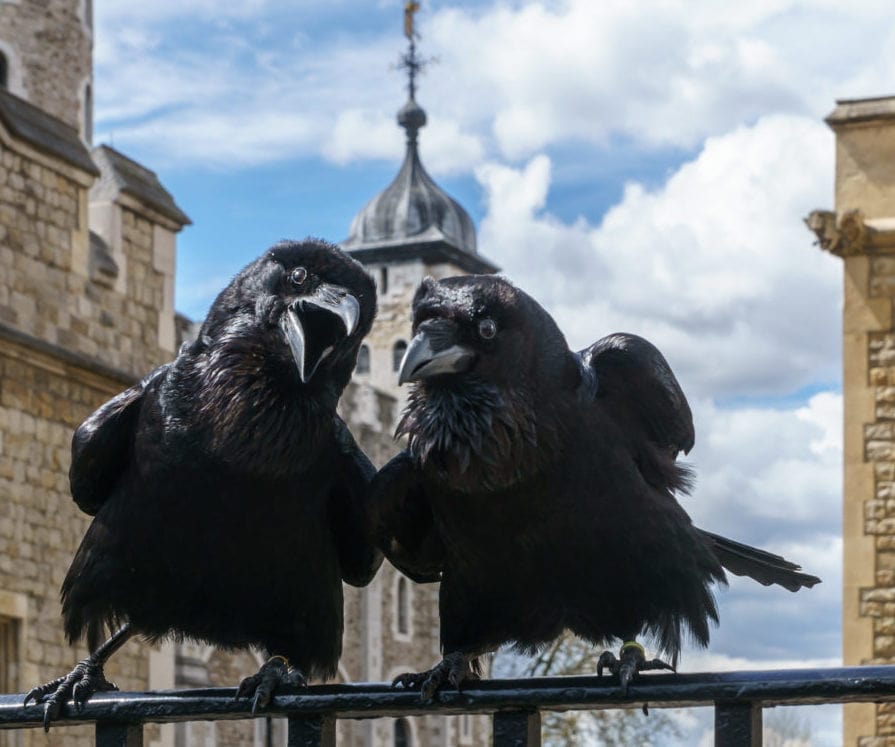
The Ravens are very well cared for by the Yeoman who lives on the premises of the Tower. These Yeomen do allow women into the ranks, although these days there is only one.

You have to have served for 22 years in the Armed Forces before you can apply to become a Yeoman and Amanda Clark, from Lancashire, became a Yeoman in 2017. The Yeoman even have their own pub.
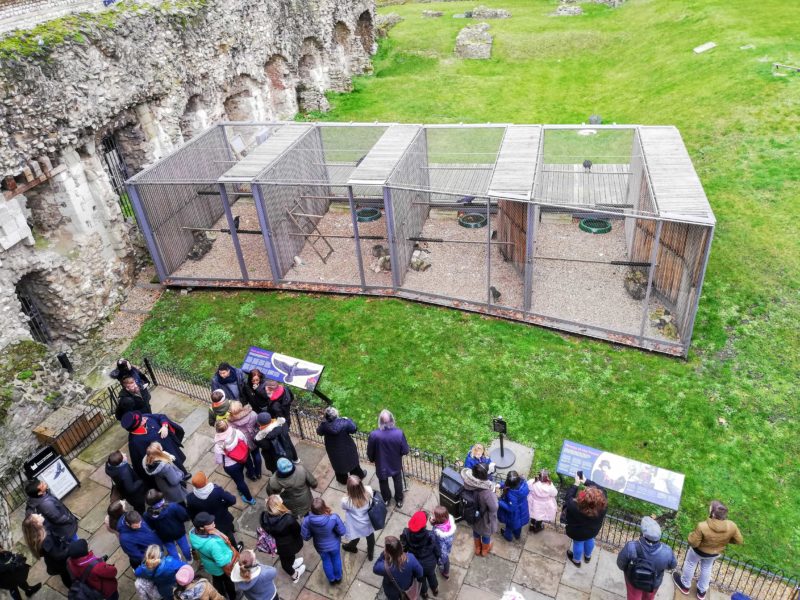
At least six ravens are kept at the Tower at all times, in accordance with the belief that if they are absent, the kingdom will fall. In 2019 the first baby ravens were born at the Tower.
Muninn and dad Huginn are the new babies’ parents and they live with seven other ravens at the Tower, including females Erin, Poppy and Merlina, and males Jubilee, Harris, Gripp and Rocky. The birds have all been bred in captivity. Muninn and Huginn arrived at the Tower at the end of 2018, and babies were not expected so quickly.
Chris Skaife is the Ravenmaster at the Tower of London and he has written a fabulous book called The Ravenmaster: My Life with the ravens which is a great read.
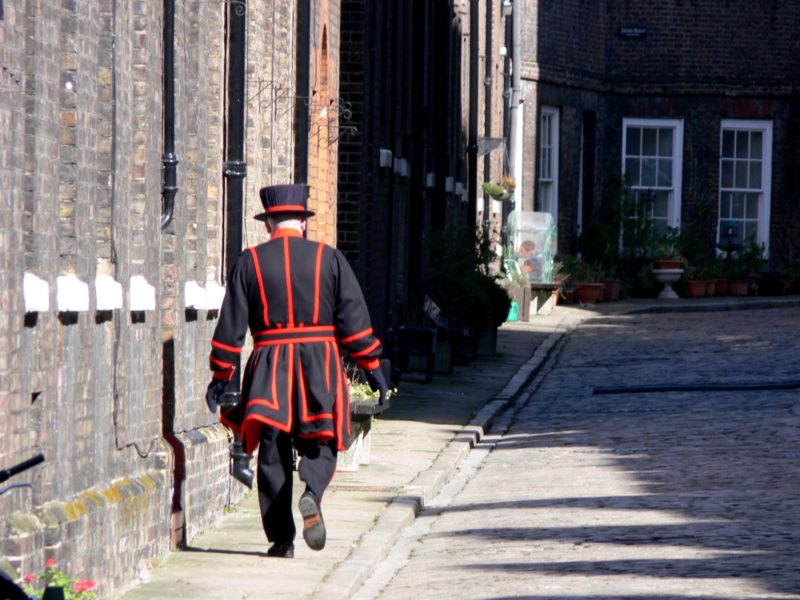
The Animals of the Tower of London
Henry I, the fourth son of William the Conqueror, founded Britain’s first “Zoo” at Oxford’s Woodstock Park in 1100. It wasn’t to enjoy the looks of them, oh no, but simply an easy way for him to contain them before hunting them down.
King John brought the animals to London from the remains of Henry 1 zoo at Oxford. Over the years the zoo would contain zebras, tigers, polar bears, lions and elephants. Sadly many of the animals died due to unsuitable diets and disease.
Scattered throughout the Tower are statues of the types of animals kept there. Keep an eye out for the monkey on the roof.
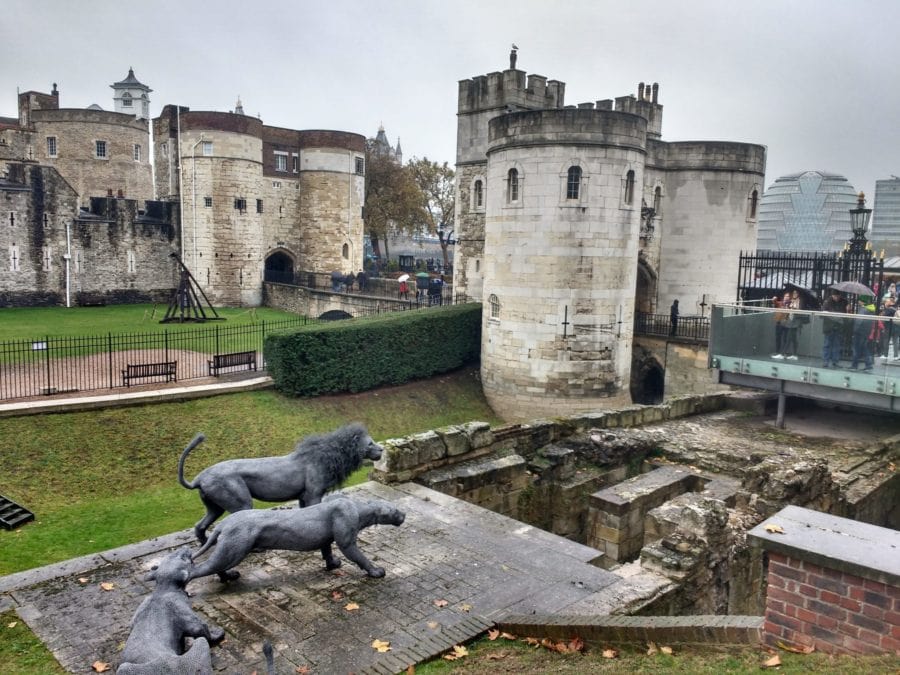
The Tower will keep you busy for a minimum of 2 hours, probably a lot more considering the crowds. You can grab a snack or lunch at one of the 4 cafes around the Tower. There is the Wharf Kiosk where you can grab a snack by the river, the New Armouries Cafe which does hot meals, tea and coffee and light snacks, or how about the Raven Cafe which serves a variety of gourmet sausages and last but not least have a great meal in the Sargeant’s Mess which serves locally sourced British classics with absolutely stunning views.
I have to admit I found these cafes a tad pricey and was pretty glad I brought my own snacks and water with me.
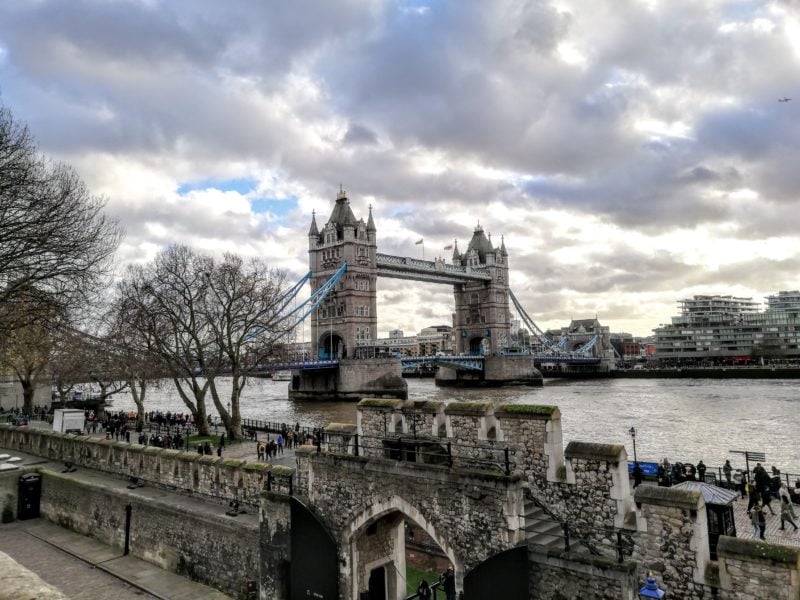
England has so many castles, in fact apparently between 600 and 700 depending on what you would call a castle. I am planning to visit Warwick Castle, Blenheim Palace, Buckingham Palace and a few others in the near future. If you want to explore Britain’s 17 most amazing castles this is an article you should read if you are planning a trip to the UK it has lots of great information on castles from N. Ireland to the south of England and even a note on buying one – if you have deep pockets.
You might also like
Ultimate Inside Buckingham Palace tour
Visiting St. Paul’s Cathedral & what to see inside
Ultimate tips for visiting the Houses of Parliament & Big Ben
Trafalgar Square London – fascinating facts
Things to do in Chelsea London
The 7 Best Places to See Street Art in London
So have you managed to get inside the Tower of London? What did you think?
Love to see more places to visit in the UK?
